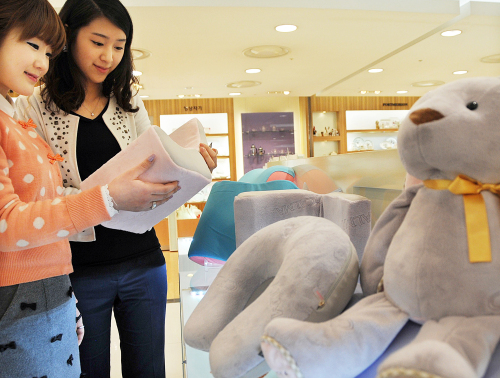
Household goods made of fiber are shown to be the most ridden with bacteria, according to a study made public Tuesday by Prof. Cheon Jong-sik of the Department of Biotechnology at Seoul National University.
Cheon found evidence of a greater number of harmful microbes in fiber-made goods such as school uniforms, doormats, pillows and goods with fiber-made parts like dolls, baby strollers, backpacks and shoe soles, compared to goods such as cellphones and toilet seats. The study contained 90 samples, 10 for each of the nine products mentioned above.
The researcher discovered an average 5.4 CFU/cm2 in non-fiber-good samples, as opposed to 520 CFU/cm2 averaged from fibered-good samples, the latter showing roughly 96 times more pathogens than the former. Even from the partial-fiber samples, he found 170 CFU/cm2 on average, 31 times higher than those samples without fiber parts. CFU, or Colony Forming Unit, is used to measure the number of cultivated bacteria in tests and 1 CFU denotes a single strain of bacterium.
Cheon, along with his team, also underlined their finding of several dangerous pathogens, microbes that tend to infect the ill, the elderly, infants and others with compromised immunity levels.
In shoes, school uniforms and pillows, the researchers found Staphylococcus warneri, the pathogens that cause bacteremia, commonly known as blood poisoning. In pillows, backpacks, cellphones and baby strollers, they identified acne-producing Propionibacterium. In dolls, they discovered among seven opportunistic pathogens Nocardia nova, the bacteria for nocardiosis. Finally, in strollers and backpacks, they noted the presence of sepsis-inducing Streptococcus pseudopneumoniae along with three other pathogens.
Meanwhile, E. coli bacteria were spotted on and only on non-fiber samples such as cellphones and toilet seats.
“We must take caution with common household goods used by infants and other people with weaker immune systems,” said Cheon.
By Jay S. Kwaak (kwaak@heraldcorp.com)
<한글 기사>
"교복•베개에 변기보다 세균 많아"
천종식 서울대 교수 조사 결과
교복•베개 등 생활 속 섬유류 제품에 휴대전화나 변기 등 비섬유 제품보다 많은 세균이 존재한다는 조사 결과가 나왔다.
천종식 서울대 생명과학부 교수 연구팀은 12일 교복•발매트•베개 등 섬유제품, 인형•유모차•유치원가방•신발 깔창 등 섬유와 비섬유(고무 등)가 섞인 제품, 휴대전화•변기 등 비섬유제품을 대상으로 세균 검사를 진행한 결과 이 같은 사실을 확인했다고 밝혔다.
연구팀은 이 9가지 품목마다 서울•경기 지역에서 10개 샘플을 수집, 모두 90개 시료를 분석 대상으로 사용했다.
분석 결과, 휴대전화와 변기 등 비섬유제품에서 평균 5.4CFU/㎠의 세균이 검출된 데 비해 교복•발매트•베개에서는 평균 520CFU/㎠가 넘는 세균이 발견됐다. 비 섬유류의 96배 수준이다.
인형•유모차•유치원가방•신발 깔창 등 섬유 및 비섬유 혼합제품에서도 비섬유류의 31배인 평균 170CFU/㎠의 세균이 나왔다.
CFU(Colony Forming Unit)는 세균을 검출할 때 배양이 되는 세균의 수를 측정하는 단위로 1CFU는 세균 1마리를 뜻한다.
아울러 연구팀은 이번 조사에서 생활 주변 제품에서 여러 종류의 기회감염성 세균이 발견된 사실을 강조했다. '기회감염성' 세균이란 정상인에게는 큰 문제가 되지 않지만, 환자•노약자•유아 등 면역력이 약한 사람에게 질병을 일으킬 수 있는 미생물이다.
신발•교복•베개의 경우 균혈증(균이 혈액을 통해 온몸을 순환하는 상태)을 야 기하는 기회감염균이자 포도상구균의 일종인 '스태필로코커스 와르네리(Staphylococ cus warneri)'가 나왔고, 베개•가방•휴대폰•유모차에서는 여드름을 유발하는 '프로피오니박테리움 에크니(Propionibacterium acnes)'가 확인됐다.
인형에서는 노카르디아증의 원인인 '노카르디아 노바(Nocardia nova)' 등 7종, 유모차와 가방에서는 패혈증을 일으키는 '스트렙토코커스 수도뉴모니아(Streptococc us pseudopneumoniae)' 등 각 4종의 기회감염균이 나왔다.
대장균의 경우 섬유류에서는 나오지 않았고, 비섬유류인 휴대전화와 변기에서만 검출됐다.
천 교수는 "유아 등 면역력이 약한 사람이 사용하는 생활제품의 청결에 주의해야 한다"고 말했다.
(연합뉴스)
"교복•베개에 변기보다 세균 많아"
천종식 서울대 교수 조사 결과
교복•베개 등 생활 속 섬유류 제품에 휴대전화나 변기 등 비섬유 제품보다 많은 세균이 존재한다는 조사 결과가 나왔다.
천종식 서울대 생명과학부 교수 연구팀은 12일 교복•발매트•베개 등 섬유제품, 인형•유모차•유치원가방•신발 깔창 등 섬유와 비섬유(고무 등)가 섞인 제품, 휴대전화•변기 등 비섬유제품을 대상으로 세균 검사를 진행한 결과 이 같은 사실을 확인했다고 밝혔다.
연구팀은 이 9가지 품목마다 서울•경기 지역에서 10개 샘플을 수집, 모두 90개 시료를 분석 대상으로 사용했다.
분석 결과, 휴대전화와 변기 등 비섬유제품에서 평균 5.4CFU/㎠의 세균이 검출된 데 비해 교복•발매트•베개에서는 평균 520CFU/㎠가 넘는 세균이 발견됐다. 비 섬유류의 96배 수준이다.
인형•유모차•유치원가방•신발 깔창 등 섬유 및 비섬유 혼합제품에서도 비섬유류의 31배인 평균 170CFU/㎠의 세균이 나왔다.
CFU(Colony Forming Unit)는 세균을 검출할 때 배양이 되는 세균의 수를 측정하는 단위로 1CFU는 세균 1마리를 뜻한다.
아울러 연구팀은 이번 조사에서 생활 주변 제품에서 여러 종류의 기회감염성 세균이 발견된 사실을 강조했다. '기회감염성' 세균이란 정상인에게는 큰 문제가 되지 않지만, 환자•노약자•유아 등 면역력이 약한 사람에게 질병을 일으킬 수 있는 미생물이다.
신발•교복•베개의 경우 균혈증(균이 혈액을 통해 온몸을 순환하는 상태)을 야 기하는 기회감염균이자 포도상구균의 일종인 '스태필로코커스 와르네리(Staphylococ cus warneri)'가 나왔고, 베개•가방•휴대폰•유모차에서는 여드름을 유발하는 '프로피오니박테리움 에크니(Propionibacterium acnes)'가 확인됐다.
인형에서는 노카르디아증의 원인인 '노카르디아 노바(Nocardia nova)' 등 7종, 유모차와 가방에서는 패혈증을 일으키는 '스트렙토코커스 수도뉴모니아(Streptococc us pseudopneumoniae)' 등 각 4종의 기회감염균이 나왔다.
대장균의 경우 섬유류에서는 나오지 않았고, 비섬유류인 휴대전화와 변기에서만 검출됐다.
천 교수는 "유아 등 면역력이 약한 사람이 사용하는 생활제품의 청결에 주의해야 한다"고 말했다.
(연합뉴스)


















![[Today’s K-pop] Treasure to publish magazine for debut anniversary](http://res.heraldm.com/phpwas/restmb_idxmake.php?idx=642&simg=/content/image/2024/07/26/20240726050551_0.jpg&u=)